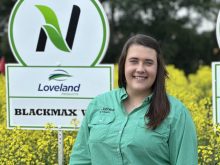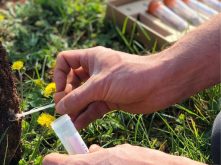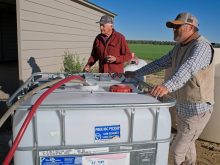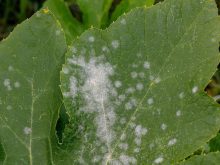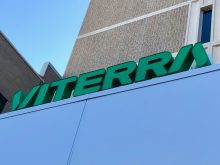Glacier FarmMedia — Photodynamic inactivation is not a phrase used in everyday conversation, but it could become an effective control of insect and fungal pests in agriculture.
“Photodynamic Inactivation (PDI) of micro-organisms using natural photosensitizers has shown itself to be a powerful tool to combat bacteria and fungi (in crops),” says a 2019 paper published on Pubmed, written by scientists from Austria and a researcher from Suncor AgroScience in Canada.
It may be surprising to hear that Suncor, a major petroleum company, has an agro-science division, especially one that studies novel technologies to control crop pests.
Read Also

Cancer agency reclassifies another herbicide ‘probably carcinogenic’
The WHO’s cancer research agency has now put atrazine, a herbicide well known to corn growers, in the same potential-hazard category where the agency put glyphosate.
However, it had such a division for years, until Nutrien purchased its agro-science assets in June.
“The acquisition is aligned with Nutrien Ag Solutions’ strategy to invest in novel, patented and effective biocontrol technologies through its Loveland Products business,” Nutrien said in a June 17 release.
Nutrien owns Loveland Products, a company in Colorado, which offers “a complete line of high performance input products” for the ag industry.
Suncor founded its agro-science division more than 20 years ago, mostly to produce agricultural adjuvants.
“The reason it was created, back in the day, was because of the lubricants they could obtain,” says Francisco Manzano, director of business development for Loveland Products.
“Those lubricants can be further processed into adjuvants for the agricultural industry.”
An adjuvant is a substance added to a spray mixture to enhance performance of the active ingredient that kills weeds and other crop pests.
Suncor sold its adjuvant business but research continued in the agro-science division. One of its discoveries was a plant extract known as a photosensitizer.
“We were interested in their photosensitizer technology,” Manzano says.
“It’s a biocontrol product against pests and pathogens. It works both against insects and mites, as well as fungal disease (and) viral and bacterial diseases.”
A photosensitizer is not a typical pest control product. The main ingredient in this case is magnesium chlorophyllin, a photosensitizer extracted from plants. A photosensitizer is a molecule that, when exposed to light, produces reactive oxygen species that will kill pathogens
As Manzano explains, “when these products are sprayed onto the pest or the pathogen, and it is exposed to light, any form of light, that light will activate the compound … and release reactive oxygen species.
“Those reactive oxygen species will pierce into the … exoskeleton of insects and lead to mortality.”
A Science Daily report says that reactive oxygen species (ROS) are “molecules containing oxygen” that are highly toxic.
“ROS damage cellular machinery and can trigger a harmful stress response if their levels are not kept in tight check.”
The photosensitizer works similarly on fungi and other crop pests. It disrupts the membrane of a fungus, which leads to dehydration and death, Manzano said.
Photosensitizers only function when exposed to light so they can’t be used on insects or fungi in the soil.
Nutrien acquired the technology, the patents and about 140 efficacy studies that third parties conducted for Suncor Agro-Science. Those studies suggest the biocontrol is highly effective against certain insects.
“These products work phenomenally well in soft-bodied insects. Your aphids, your mites, your white flies,” Manzano says.
It is less effective on hard-bodied insects, such as beetles.
As for fungal pathogens, it’s effective on a range of pests, Manzano said.
“The product works just as good as other biological forms of control but many times it’s just as good … as synthetic chemistry … as a broad-spectrum fungicide.”
It’s unlikely that pests will develop resistance to the technology, Manzano adds.
“This presents itself as a great IPM (integrated pest management) tool; a tool to rotate with chemistry to prevent the resistance issues.”
Loveland plans to sell its photosensitizer bio-control into the horticultural and broad-acre crop markets.
The company is “investing significant dollars” to develop a product label for a wide range of crops, Manzano said.
As for regulation, Loveland and Nutrien are in a pre-submission stage with the Pest Management Regulatory Agency in Canada.
In the U.S., they hope to make a regulatory submission in about 18 months.
“Product submissions to the EPA in the U.S. are anticipated by 2026,” Nutrien said in a release.





